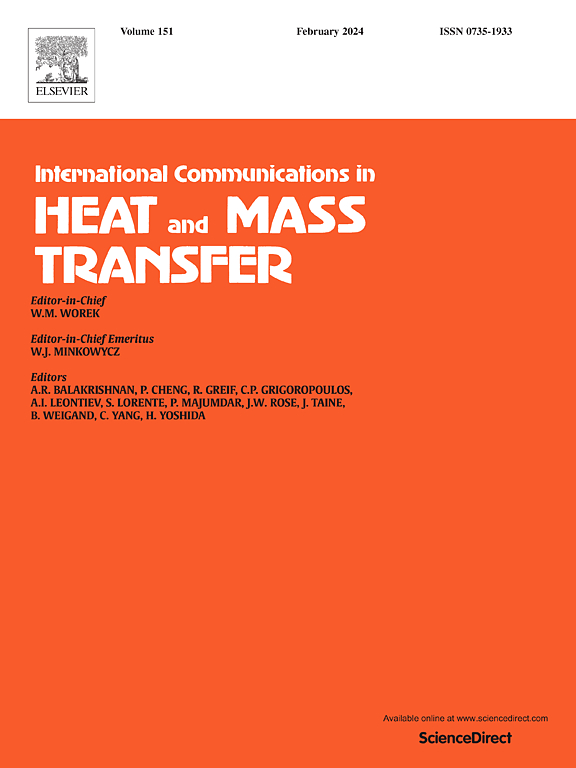Numerical analysis of MHD combined convection for enhanced CPU cooling in NEPCM-filled a trapezoidal cavity
IF 6.4
2区 工程技术
Q1 MECHANICS
International Communications in Heat and Mass Transfer
Pub Date : 2024-11-16
DOI:10.1016/j.icheatmasstransfer.2024.108343
引用次数: 0
Abstract
This study investigates the cooling of a central processing unit (CPU) using a nano-encapsulated phase change material (NEPCM)-water mixture in a trapezoidal cavity with rotating cylinders and baffles. A numerical model based on the finite element method (FEM) is employed to solve the governing equations. The system is subjected to a sinusoidal temperature profile from the CPU and a constant magnetic field. Key parameters examined include Reynolds number (Re: 10–100), Richardson number (Ri: 0.1–10), Hartmann number (Ha: 5–80), NEPCM volume fraction (ϕ: 0.015–0.035), Lewis number (Le: 0.1–10), buoyancy ratio (Nz: 1–5), NEPCM fusion temperature (θf: 0.1–0.9), and Stefan number (Ste: 0.1–0.9). Results show that increasing Re and Ri significantly enhances heat and mass transfer, with the average Nusselt number (Nuav) increasing by up to 80.5 % and average Sherwood number (Shav) by up to 147.9 %. The magnetic field suppresses convection, reducing Nuav by 12.7 % and Shav by 39.5 % as Ha increases. Increasing ϕ improves heat transfer (Nuav up by 32.5 %) with minimal effect on mass transfer. Le strongly influences mass transfer, with Shav increasing by 284.6 % as Le increases. The NEPCM fusion temperature exhibits a non-monotonic effect on Nuav, with an optimal value at θf = 0.5. In conclusion, the study reveals complex interactions between parameters, with Re, Ri, and Le having the most significant impacts on system performance. These findings provide valuable insights for optimizing CPU cooling systems using NEPCM-water mixtures and magnetohydrodynamic (MHD) effects.
用于增强 NEPCM 填充梯形空腔中 CPU 冷却的 MHD 联合对流数值分析
本研究探讨了在带有旋转圆柱和挡板的梯形空腔中使用纳米封装相变材料(NEPCM)-水混合物冷却中央处理器(CPU)的问题。采用基于有限元法 (FEM) 的数值模型来求解控制方程。系统受到来自中央处理器的正弦温度曲线和恒定磁场的影响。研究的主要参数包括雷诺数 (Re:10-100)、理查德森数 (Ri:0.1-10)、哈特曼数 (Ha:5-80)、NEPCM 体积分数 (j:0.015-0.035)、路易斯数 (Le:0.1-10)、浮力比 (Nz:1-5)、NEPCM 融合温度 (θf:0.1-0.9) 和斯特凡数 (Ste:0.1-0.9)。结果表明,增加 Re 和 Ri 能显著增强传热和传质,平均努塞尔数 (Nuav) 最多增加 80.5%,平均舍伍德数 (Shav) 最多增加 147.9%。磁场抑制了对流,随着 Ha 的增加,Nuav 降低了 12.7%,Shav 降低了 39.5%。增加 ϕ 可以改善传热(Nuav 增加 32.5%),但对传质的影响很小。Le 对传质影响很大,随着 Le 的增加,Shav 增加了 284.6%。NEPCM 熔融温度对 Nuav 的影响是非单调的,最佳值为 θf = 0.5。总之,研究揭示了参数之间复杂的相互作用,其中 Re、Ri 和 Le 对系统性能的影响最大。这些发现为使用 NEPCM 水混合物和磁流体动力 (MHD) 效应优化 CPU 冷却系统提供了宝贵的见解。
本文章由计算机程序翻译,如有差异,请以英文原文为准。
求助全文
约1分钟内获得全文
求助全文
来源期刊
CiteScore
11.00
自引率
10.00%
发文量
648
审稿时长
32 days
期刊介绍:
International Communications in Heat and Mass Transfer serves as a world forum for the rapid dissemination of new ideas, new measurement techniques, preliminary findings of ongoing investigations, discussions, and criticisms in the field of heat and mass transfer. Two types of manuscript will be considered for publication: communications (short reports of new work or discussions of work which has already been published) and summaries (abstracts of reports, theses or manuscripts which are too long for publication in full). Together with its companion publication, International Journal of Heat and Mass Transfer, with which it shares the same Board of Editors, this journal is read by research workers and engineers throughout the world.

 求助内容:
求助内容: 应助结果提醒方式:
应助结果提醒方式:


